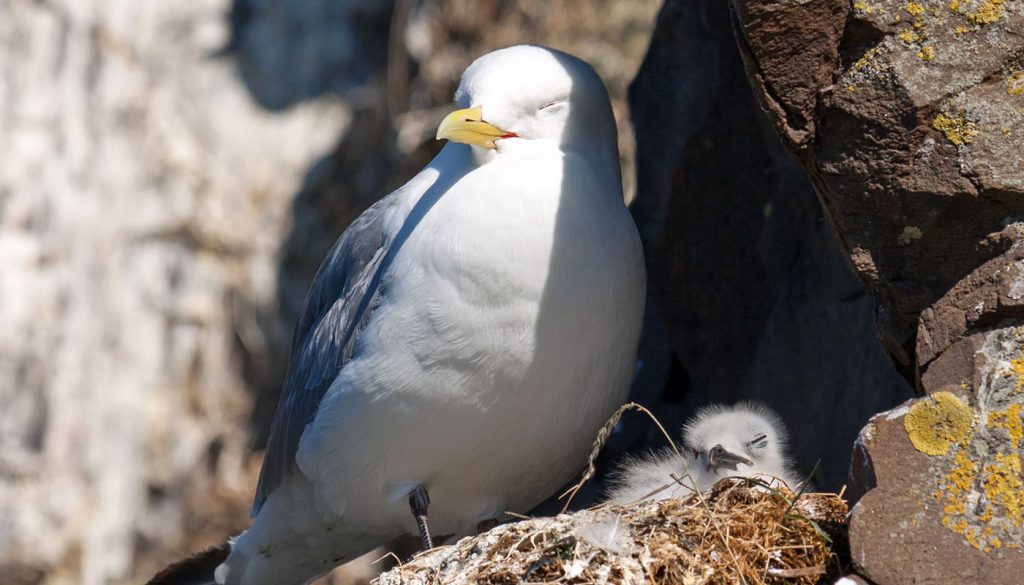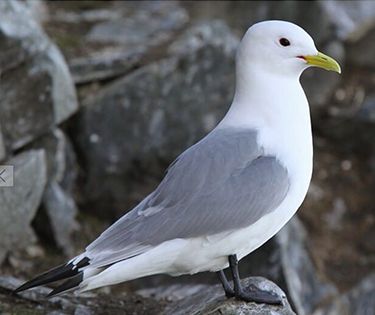
Perched high on the jagged sea cliffs of Skellig Michael, the Kittiwake is a true embodiment of grace and beauty. With its pristine white plumage, dark wingtips, and gentle, delicate features, this gull stands out among the rugged landscape it calls home.
The Kittiwake, also known as Rissa tridactyla, is a common sight on these remote Irish cliffs, captivating both bird enthusiasts and casual observers alike. Its aerial acrobatics and melodious calls lend an enchanting aura to the surroundings, creating a sense of tranquility amidst the roaring ocean waves.
These seabirds are highly adaptable creatures, perfectly suited to their habitat. From their impressive cliffside nests to their streamlined bodies built for swift, efficient flight, the Kittiwake embodies elegance in motion. Their graceful movements and serene demeanor inspire a sense of wonder and awe.

The Kittiwake, a seabird that thrives in the rugged coastal environments, finds its primary habitat along steep cliffs and rocky shorelines. This species is particularly fond of marine environments, where it can access abundant food sources in the turbulent waters below. Skellig Michael, with its towering cliffs and isolated position in the Atlantic Ocean, offers an ideal nesting ground for these graceful gulls. The sheer verticality of the cliffs provides safety from land-based predators, allowing Kittiwakes to breed and raise their young in relative peace.
In terms of distribution, Kittiwakes can be found across the North Atlantic, with significant populations in regions including Norway, Iceland, and the British Isles. During the breeding season, which typically spans from late March to early August, these birds congregate in large colonies on cliffs and ledges. Their preference for high-altitude nesting sites not only provides a vantage point for spotting predators but also positions them closer to their food sources. Kittiwakes are adept at foraging for fish and other marine life, and their choice of nesting location significantly enhances their feeding efficiency and overall survival.
Skellig Michael’s unique geographical features also influence the Kittiwake’s distribution. The island’s remote location and challenging access ensure that it remains a sanctuary for these birds, away from the disturbances common in more populated coastal areas. As a result, Skellig Michael has become a vital breeding ground for Kittiwakes, contributing to the overall health of their population in the region. The island’s rich biodiversity and the presence of other seabird species further enhance the ecological significance of this habitat, making it a critical area for conservation efforts aimed at preserving the delicate balance of marine ecosystems.
Kittiwakes have evolved several remarkable adaptations that enable them to thrive in their cliffside habitats. One of the most notable features is their physical structure, which includes a lightweight skeletal system that facilitates agile flight. Their streamlined bodies are designed for swift movements, allowing them to navigate the gusty winds that often buffet the cliffs they inhabit. This aerodynamic design is essential for both foraging and escaping potential threats. Additionally, their long, narrow wings give them the ability to soar gracefully over the water, covering large distances in search of food.
Another unique adaptation of Kittiwakes is their choice of nesting materials and construction techniques. Kittiwakes are known for building nests from a variety of available materials, including seaweed, grass, and even small pebbles. These nests are often constructed in tight clusters on the cliffs, allowing them to maximize space and reduce the risk of predation. The nests are built on ledges that provide stability, further enhancing their safety during breeding. This communal nesting behavior also fosters a sense of security, as the presence of numerous birds can deter potential predators from approaching.
Furthermore, Kittiwakes exhibit strong parental care, which is crucial for the success of their offspring in such a precarious environment. Both parents share the responsibility of incubating the eggs and feeding the chicks, ensuring that they receive the necessary nutrients to grow and develop. This cooperative breeding strategy is particularly effective in cliff nesting, where the challenges of finding food and protecting young birds are amplified. The nurturing instincts of Kittiwakes, combined with their impressive adaptations, underscore their resilience and ability to thrive in one of nature’s most demanding habitats.
Your are about to book a trip to land on Skellig Michael a world Heritage site. The journey to the Islands is approximately 50 minutes. Under normal weather conditions you will be allowed 2.5 hrs on the Skelligs. Allow 5 hrs from when you board the boat in the morning to when you again disembark at the marina in the afternoon. Finally enjoy your day with us, we will do everything to make it a memorable journey.
The eco tour has multiple departures times throughout the day depending on the sea conditions. The boat tour takes approximately 2 hours and 25 minutes and circles both islands getting right up close to Skellig Michael and the small Skelligs to see both the wildlife and the historical sites. This tour can get quite busy especially in the peak season so it is advisable to book well in advance. This tour does not land on the Island.
Copyright © 2025 | Skelligs Rock Cruises
WhatsApp us